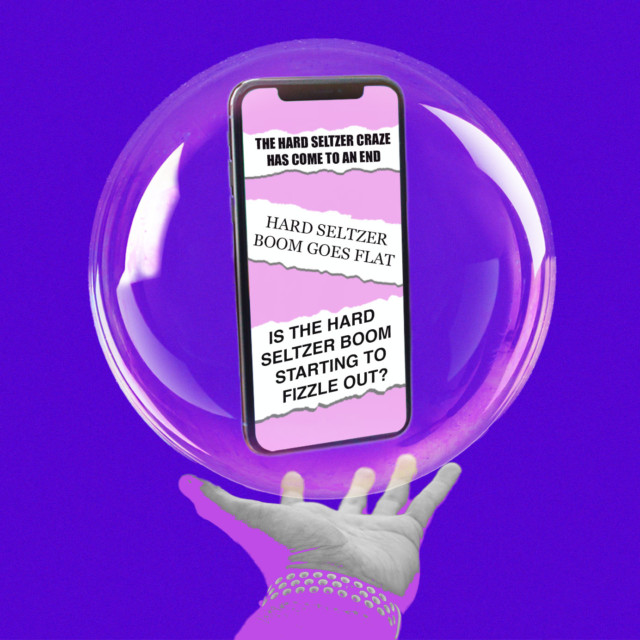Such was the broader alcohol industry’s reluctance to accept hard seltzer as more than a fad in its 2019 breakout year, it was only a matter of time before some declared the bubble officially burst. To co-opt an old adage: The bigger you are, the harder your skeptics want to see you fall.
And so those headlines flowed last Friday. “The hard seltzer craze has come to an end,” declared CNN Business. “Hard seltzer boom goes flat,” reported Reuters. And if it hasn’t already been published, it’s only a matter of time before another outlet opts for: “Hard seltzer fizzes out.”
To put it bluntly, these takes are wrong.
The premature declaration of seltzer’s demise followed the second-quarter earning’s report from one of the segment’s main players, Boston Beer. On Thursday evening, it became apparent that the publicly traded parent company of Truly Hard Seltzer was too aggressive in its projections. Initially forecasting 40 – 50 percent volume growth for the year, Boston backtracked to a more conservative projection of 25 – 40 percent.
The news saw shares slump on Friday, with Boston’s stock closing 26 percent down by the end of trading, according to CNBC. CEO David Burwick was forced to face the music and concede: “We don’t look very smart.”
This must have been something of a bitter, lightly-flavored beverage for Burwick to swallow, not least because his company’s revenues rose 33.3 percent during the period, and hard seltzer, by all accounts, continues to grow.
While YoY off-premise alcohol sales dropped overall during the 2021 July 4th weekend, hard seltzer remained strong. The category accounted for 13 percent of all the retail dollars spent on alcohol during the holiday weekend, according to a recently published report from NielsenIQ. To put that figure into perspective, this is the highest share seltzer has ever held in Nielsen-tracked channels. In reaching a total of $280 million, the category outperformed all red table wine.
Hard Seltzer’s 2021 Slump Growth
When considering the broader perspective of seltzer’s performance this year, the picture looks similarly promising. The segment now accounts for a 7 percent share of total beverage alcohol sales, per IRI data shared by the trade publication Beverage Industry. Hard seltzer SKUs also account for eight of the top 10 dollar growth beer brands year-to-date (YTD), according to Nielsen data viewed by VinePair.
Truly occupies three spots on that list, with its Iced Tea, Punch, and Lemonade mix packs posting a combined $236 million in growth. (The former two SKUs, it should be noted, were not available last year, so their growth also equates to total sales.) Given that Boston Beer is under the microscope, we could also point out that its Twisted Tea brand has grown an impressive $42 million YTD — and that’s a line that has been on a quiet tear for decades.
Hard seltzer sales are, therefore, unequivocally not falling flat. Sure, growth is slowing, but most who follow the segment would hardly be surprised by this.
Though it’s grown at breakneck speed — and even because of this — the category is much more mature than during the White Claw summer of just two years ago. With every dollar that the category grows, the opportunities for seltzer brands to convert beer, wine, and spirits drinkers, and steal share from those beverages, decreases. Contrary to what a Friday night in New York’s East Village might suggest, there is some finite limit to the amount of alcohol Americans can consume.
Then there’s the pandemic to consider. During the first and second quarters of 2020, almost all drinking took place at home and in public outdoor spaces. With vaccination levels rising, that’s no longer the case. And as the Mark Anthony’s and Boston Beer’s of the world would surely admit, the on-premise is the only area in which hard seltzer has truly underperformed to date.
Still, hard seltzer continues to outpace total alcohol and beer growth in the off-premise, as Good Beer Hunting’s Brian Roth highlighted in a handy chart, posted to Twitter on Sunday.
"thE hARd sELtZer cRaZE hAs cOME tO an eNd" pic.twitter.com/jgkn3Zkb90
— Bryan Roth (@BryanDRoth) July 25, 2021
So the tale of seltzer’s demise is nothing more than some snappy (inaccurate) headlines, and what industry analysts so often describe as overly “bullish” projections from the second-best-selling hard seltzer producer. Though Goldman Sachs has downgraded the company’s stock from buy to neutral, we should probably take that more as an indictment of Boston’s ability to project sales, rather than confidence in hard seltzer as a whole.
This is nothing particularly new, though. Beverage industry analysts have run out of superlatives to describe hard seltzer’s rise, yet no one seems to have the definitive answer for if, when, and how it will all end. But it certainly isn’t here and now.
“It’s a really, really murky crystal ball,” Boston Beer founder Jim Koch admitted during a recent conference call with investors and analysts. “It’s more like looking into a bowling ball. You can’t see much.”
At the company’s Massachusetts headquarters, Boston execs will still surely be kicking themselves. That their stock is currently trading some 533 percent higher than this time five years ago may offer some consolation.
This story is a part of VP Pro, our free platform and newsletter for drinks industry professionals, covering wine, beer, liquor, and beyond. Sign up for VP Pro now!
